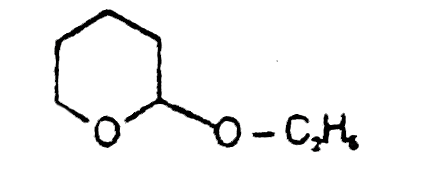Intermediate product of hydrolysis of cyanide is
RCOONH4
RCONH2
R−C∣OH=NH
R−C≡⊕NH
The correct Answer is:B
To determine the intermediate product of hydrolysis of cyanide, we can analyze the process step by step.
1. Understanding Cyanide Hydrolysis:
- Cyanides (R-C≡N) can undergo hydrolysis in both acidic and basic conditions to form different products. The hydrolysis process involves the addition of water (H₂O) to the cyanide.
2. Hydrolysis in Basic Medium:
- In a basic medium, hydroxide ions (OH⁻) attack the carbon atom of the cyanide (R-C≡N).
- This results in the formation of an intermediate product, which is an amide (R-C(=O)-NH₂).
3. Formation of Amide:
- The reaction proceeds with the formation of an amide as the intermediate product. The reaction can be summarized as:
- R-C≡N + OH⁻ → R-C(=O)-NH₂ (amide)
4. Further Hydrolysis:
- The amide can further react with hydroxide ions to eventually form a carboxylic acid (R-COOH). However, the question specifically asks for the intermediate product, which is the amide.
5. Hydrolysis in Acidic Medium:
- In acidic conditions, the nitrogen of the cyanide is protonated (R-C≡NH⁺), and then water attacks to form an amide (R-C(=O)-NH₂) as well.
- The steps are similar to those in the basic medium, leading to the same intermediate product.
6. Conclusion:
- In both acidic and basic hydrolysis of cyanide, the intermediate product formed is an amide (R-C(=O)-NH₂). Therefore, the correct answer is that the intermediate product of hydrolysis of cyanide is an amide.
Final Answer:
The intermediate product of hydrolysis of cyanide is R-C(=O)-NH₂ (amide).
- Cyanides (R-C≡N) can undergo hydrolysis in both acidic and basic conditions to form different products. The hydrolysis process involves the addition of water (H₂O) to the cyanide.
- In a basic medium, hydroxide ions (OH⁻) attack the carbon atom of the cyanide (R-C≡N).
- This results in the formation of an intermediate product, which is an amide (R-C(=O)-NH₂).
- The reaction proceeds with the formation of an amide as the intermediate product. The reaction can be summarized as:
- R-C≡N + OH⁻ → R-C(=O)-NH₂ (amide)
- The amide can further react with hydroxide ions to eventually form a carboxylic acid (R-COOH). However, the question specifically asks for the intermediate product, which is the amide.
- In acidic conditions, the nitrogen of the cyanide is protonated (R-C≡NH⁺), and then water attacks to form an amide (R-C(=O)-NH₂) as well.
- The steps are similar to those in the basic medium, leading to the same intermediate product.
- In both acidic and basic hydrolysis of cyanide, the intermediate product formed is an amide (R-C(=O)-NH₂). Therefore, the correct answer is that the intermediate product of hydrolysis of cyanide is an amide.
The intermediate product of hydrolysis of cyanide is R-C(=O)-NH₂ (amide).
Topper's Solved these Questions
Similar Questions
Knowledge Check
- Question 1 - Select One
Final product of hydrolysed alkyl cyanide is
ARCOOHBRCONH2CR−C∣OH=NHDR−C≡⊕NH - Question 2 - Select One
Final product of. hydrolysed alkyl cyanide is
AR COOHBR CONH2CR−C∣OH=NHDR−C≡⊕NH - Question 3 - Select One
The product of acid hydrolysis of

isAHOCH2CH2CH2CH2CHO+CH3CHOBHOCH2CH2CH2CH2CH2OH+CH3CHOCHOCH2CH2CH2CH2CHO+C2H5OHDHOCH2CH2CH2CH2CH2OH+C2H5OH
The ultimate product of the hydrolysis of starch is
View SolutionEnd-product of the hydrolysis of XeF6 is :
View SolutionEnd-product of the hydrolysis of XeF6 is :
View SolutionWhat is the initial product of the acidic hydrolysis of a cyanide
View SolutionAcid hydrolysis of cyanide may produces
View Solution

